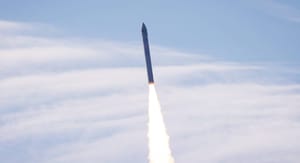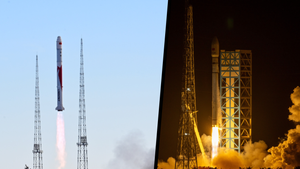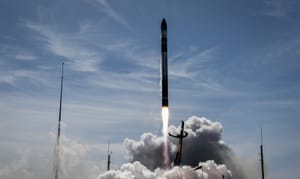
Vulcan soars for second certification flight!
Today's launch marks the final National Security Space Launch certification flight for United Launch Alliance’s Vulcan rocket! This launch was also the second successful flight of Blue Origins BE-4 engines.
At 11:25 am Universal Coordinated Time, ULA’s Vulcan Centaur lifted off from Launch Complex 41 for the second time. The mission was originally planned to launch Sierra Space’s Dreamchaser spacecraft, but due to delays it instead carried a payload mass simulator and some experiments, which it successfully inserted into the targeted orbit despite an anomaly occurring with one of the two GEM-63XL solid rocket boosters, for which its two BE-4s were able to compensate.

Details about this anomaly have not yet been shared by United Launch Alliance, but the anomaly is thought to be related to the liberation of the solid boosters nozzle. The throat of the nozzle is believed to have remained in place with just the lower section coming free.
Some of these experiments onboard are believed to be related to United Launch Alliance's plans for long-duration cryogenic upper-stages for complex capability-needing missions in the future, possibly with burns months apart or for refueling and heading deeper into space.
After the mission was declared successful, Tory Bruno, United Launch Alliance's President and Chief Executive Officer, said:
“The success of Vulcan’s second certification flight heralds a new age of forward-looking technology committed to meeting the ever-growing requirements of space launch and supporting our nation’s assured access to space. We had an observation on one of our solid rocket boosters that we are reviewing but overall, we are pleased with the rocket’s performance and had a bullseye insertion”
The next flight of Vulcan is planned to loft USSF-106 into orbit on the vehicle's first National Security Space Launch mission later this year. It will also be the debut of Vulcan's VC4S configuration and will be powered by the 5th and 6th Blue Origin BE-4s to fly, meaning that Vulcan will have flown almost the same amount of BE-4s present on New Glenn's first stage.
Vulcan's previous flight also flew perfectly toward the Moon while carrying the eventually unsuccessful Peregrine lunar lander from Astrobotic. That mission served as the first certification mission for the United States Space Force.
National Security Space Launch certification is handled by the United States Space Force to guarantee access to space for Department of Defense payloads and sensitive technology missions. These are missions like reconnaissance satellite launches for the National Reconnaissance Office, NASA's DRACO nuclear propulsion demonstration, or the X-37B spaceplane for the Space Force.
United Launch Alliance is believed to have sold over seventy launches for Vulcan with eleven for the United States Space Force, six for the Sierra Nevada Corporation to carry its Dream Chaser spaceplane, and thirty-eight for Amazon to launch its 'Project Kuiper' satellites. The rest of the payloads flying on Vulcan-Centaur are not yet known publically.
What is Vulcan?
Vulcan, sometimes just called Vulcan-Centaur, is United Launch Alliance's in-development two-stage rocket. Vulcan is planned to replace the company's Atlas V and Delta IV Heavy launch vehicles in the coming decade.

The first-stage is powered by two BE-4 engines generating 500 tons of thrust burning liquid methane and liquid oxygen for four minutes and fifty-nine seconds. Blue Origin manufactures the BE-4 engines for use with United Launch Alliance as well as Blue Origin's upcoming New Glenn rocket.
The second-stage is powered by two RL-10 engines generating 22 tons of thrust burning liquid hydrogen and liquid oxygen. Aerojet Rocketdyne manufactures the RL-10 engines for use with United Launch Alliance. This stage is also called Centaur V due to the rocket stages' heritage.
Vulcan-Centaur can also launch with either zero, two, four, or six GEM-63XL solid rocket motors to augment the rockets thrust and capabilities. Each booster burns a solid propellant, consisting of Hydroxyl-terminated polybutadiene and Aluminum-Ammonium perchlorate, generating 224 tons of thrust each for a believed one minute and fifty seconds. The solid rocket boosters are manufactured by Northrop Grumman for use with United Launch Alliance.
Two fairing sizes are offered for Vulcan to suit customer needs, both 5.4 meters in diameter. The standard fairing is 15.5 meters long while the extended long fairing is 21.3 meters long. A 'multi-manifest' version of the 21.3-meter long fairing is also available for launching multiple spacecraft on a single launch.
In the table below, United Launch Alliance claims Vulcan-Centaur can deliver the following amount of payload in its four potential configurations.
| Vulcan Centaur VC0 | 10,800 kilograms to low Earth orbit, 3,500 kilograms to geosynchronous transfer orbit, or 2,300 kilograms to a trans-lunar injection |
| Vulcan Centaur VC2 | 19,000 kilograms to low Earth orbit, 8,400 kilograms to geosynchronous transfer orbit, or 6,300 kilograms to a trans-lunar injection |
| Vulcan Centaur VC4 | 24,600 kilograms to low Earth orbit, 11,700 kilograms to geosynchronous transfer orbit, or 9,200 kilograms to a trans-lunar injection |
| Vulcan Centaur VC6 | 27,200 kilograms to low Earth orbit, 15,300 kilograms to geosynchronous transfer orbit, or 12,100 kilograms to a trans-lunar injection |
The naming scheme of each Vulcan-Centaur configuration is as follows: V stands for Vulcan, C stands for Centaur, 0/2/4/6 stands for the amount of solid rocket motors, and S/L stands for the payload fairing length. For example, Dream Chaser would use the VC4L configuration and Astrobotic's Peregrine lunar lander would use the VC2S configuration.

Who is United Launch Alliance?
United Launch Alliance is an American aerospace company founded in December of 2006 as a joint venture between Lockheed Martin and Boeing. The company currently operates the Atlas V and Vulcan launch vehicles.




